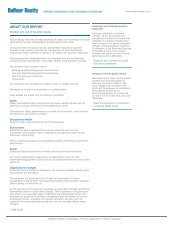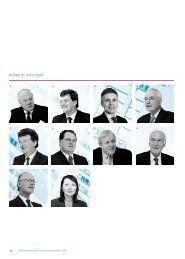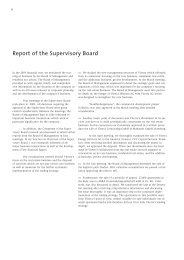E_mg_GB_03_vorne-29_3_04
E_mg_GB_03_vorne-29_3_04
E_mg_GB_03_vorne-29_3_04
Create successful ePaper yourself
Turn your PDF publications into a flip-book with our unique Google optimized e-Paper software.
152<br />
Section 307 (I) of the H<strong>GB</strong> states that minority interests must be reported as a component of shareholders’<br />
equity. Minority interests are also contained in the Group’s net income or loss for the year.<br />
Under U.S. GAAP, however, minority interests are reported not under shareholders’ equity, but<br />
separately between equity and debt capital. Consequently, minority interests must be recognized<br />
as a separate income or expense item before the consolidated net income or loss.<br />
Differences in Accounting Policies and Reporting<br />
Reinstatement of Original Values for Long-Lived Assets<br />
If an asset has been written down due to impairment pursuant to section 253 (II) and (III) of the<br />
H<strong>GB</strong>, the requirement to reinstate its original value under section 280 (I) of the H<strong>GB</strong> states that this<br />
value may not be retained if the reasons for the write-down no longer apply at a later balance sheet<br />
date. In such cases, the asset must be written up.<br />
Under U.S. GAAP, the carrying amount of a long-lived asset has to be tested for impairment if<br />
events or changed circumstances indicate that the asset’s carrying amount may exceed its fair value.<br />
Impairment is measured by comparing the estimated future discounted pre-tax cash flows of the<br />
related asset to its carrying amount. SFAS 144 (‘Accounting for the Impairment or Disposal of Long-<br />
Lived Assets’) states that original values may not be reinstated even if the reasons for such a writedown<br />
no longer apply.<br />
Leases<br />
The accounting treatment of leases is not explicitly stated in the H<strong>GB</strong>. As a rule, we have therefore<br />
based our accounting treatment on the tax authorities’ pronouncements on leases, which state that<br />
leased assets should generally be capitalized by the lessor.<br />
U.S. GAAP contain detailed rules on the recognition of leases, especially SFAS 13 (‘Accounting for<br />
Leases’). These distinguish between capital leases and operating leases, depending on who bears<br />
the main risks and derives the main opportunities arising from use of the leased assets and is therefore<br />
deemed to be the beneficial owner. With capital leases, the lessee, as beneficial owner, has to<br />
capitalize the leased assets, while the lessor has to carry them as an asset in the case of operating<br />
leases.<br />
Valuation of Inventories<br />
Inventories are reported at cost. Section 255 (II) of the H<strong>GB</strong> states that manufacturing costs may<br />
include not just compulsory items such as direct material and production costs and specific manufacturing<br />
costs, but also attributable manufacturing overheads and administrative costs, depreciation,<br />
and the cost of certain social benefits. By contrast, U.S. GAAP (ARB 43) state that, in addition to<br />
direct costs, production-related overheads, depreciation, and production-related administrative costs<br />
have to be recognized as part of manufacturing cost.









